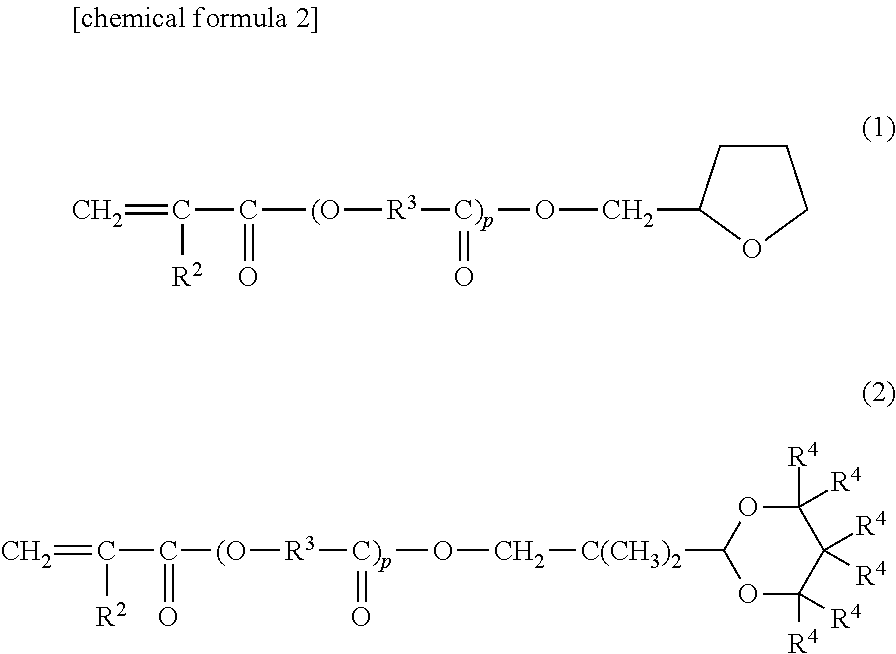Paint, adhesive composition, bonding method and laminate
a technology of adhesive composition and adhesive composition, which is applied in the direction of film/foil adhesives, carboxyl rubber coatings, transportation and packaging, etc., can solve the problems of not providing satisfactory adhesion of not satisfying the expected functionality of cured paint and adhesive composition, and not satisfying the adhesion property. , the effect of high flexibility and shock resistance, high adhesion property, and high work efficiency
- Summary
- Abstract
- Description
- Claims
- Application Information
AI Technical Summary
Benefits of technology
Problems solved by technology
Method used
Image
Examples
examples
[0252]Now, the present invention will be described further by way of examples and comparative examples, although the present invention is by no means limited by the examples that are described below.
[0253]The materials used in Examples and Comparative Examples are listed below.
Component (a-1) Vinyl Ester Resin
[0254]CN963B80: urethane acrylate (HDDA blend), type=polyester, 60° C. viscosity=1,100, number of functional groups=2, available from Sartomer Company
[0255]CN292: polyester acrylate, type=aliphatic polyester, 25° C. viscosity=630, number of functional groups=4, available from Sartomer Company
[0256]CNUVE151: epoxy acrylate, type=polyester, 25° C. viscosity=150,000, number of functional groups=2, available from Sartomer Company
(iv) Aliphatic Urethane Acrylate
[0257]CN966J75: aliphatic urethane acrylate (IBOA blend), type=polyester, 60° C. viscosity=4,240, 20° C. viscosity=105,000, number of functional groups=2, availa...
examples 1 to 38
, Comparative Examples 1 to 8
[0315]Using the compounding ratios (parts by mass) listed in Table 1 through 8 shown below, the component (a) was put into a vessel equipped with an agitator and then the component (c) was added thereto and agitated sufficiently at ambient temperature. Thereafter, the component (b) was added and agitated. When the liquid temperature got to the ambient temperature, the component (d) was added and agitated sufficiently until no unmolten residue was found to obtain an adhesive composition. The viscosity (mPa·s) at 25° C. of the obtained adhesive composition was observed. The viscosity at 25° C. was observed by means of a handy-type digital viscometer, TVC-7 type Viscometer (available from TOKI SANGYO Co., Ltd.) and a rotor (Type 0 to Type 5) that matches the different the viscosity. Tables 1 through 8 also show the obtained results.
[0316]Then, the adhesive composition was applied onto each of the specific adherends (B1) (dimensions: 150 mm×25 mm×thickness 1...
PUM
| Property | Measurement | Unit |
|---|---|---|
| Percent by mass | aaaaa | aaaaa |
| Percent by mass | aaaaa | aaaaa |
| Percent by mass | aaaaa | aaaaa |
Abstract
Description
Claims
Application Information
 Login to View More
Login to View More - R&D
- Intellectual Property
- Life Sciences
- Materials
- Tech Scout
- Unparalleled Data Quality
- Higher Quality Content
- 60% Fewer Hallucinations
Browse by: Latest US Patents, China's latest patents, Technical Efficacy Thesaurus, Application Domain, Technology Topic, Popular Technical Reports.
© 2025 PatSnap. All rights reserved.Legal|Privacy policy|Modern Slavery Act Transparency Statement|Sitemap|About US| Contact US: help@patsnap.com



